2016 DODGE GRAND CARAVAN radiator cap
[x] Cancel search: radiator capPage 570 of 707
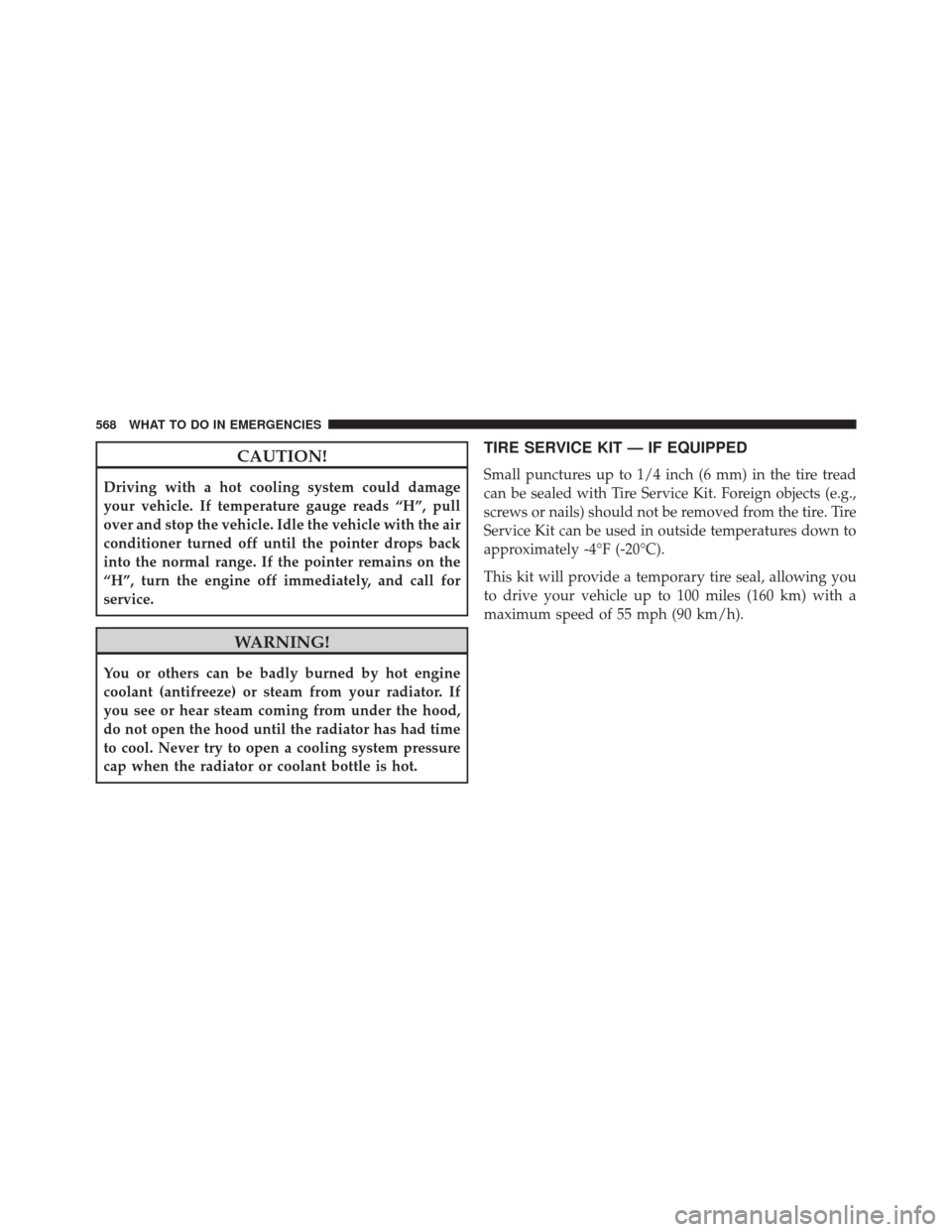
CAUTION!
Driving with a hot cooling system could damage
your vehicle. If temperature gauge reads “H”, pull
over and stop the vehicle. Idle the vehicle with the air
conditioner turned off until the pointer drops back
into the normal range. If the pointer remains on the
“H”, turn the engine off immediately, and call for
service.
WARNING!
You or others can be badly burned by hot engine
coolant (antifreeze) or steam from your radiator. If
you see or hear steam coming from under the hood,
do not open the hood until the radiator has had time
to cool. Never try to open a cooling system pressure
cap when the radiator or coolant bottle is hot.
TIRE SERVICE KIT — IF EQUIPPED
Small punctures up to 1/4 inch (6 mm) in the tire tread
can be sealed with Tire Service Kit. Foreign objects (e.g.,
screws or nails) should not be removed from the tire. Tire
Service Kit can be used in outside temperatures down to
approximately -4°F (-20°C).
This kit will provide a temporary tire seal, allowing you
to drive your vehicle up to 100 miles (160 km) with a
maximum speed of 55 mph (90 km/h).
568 WHAT TO DO IN EMERGENCIES
Page 631 of 707
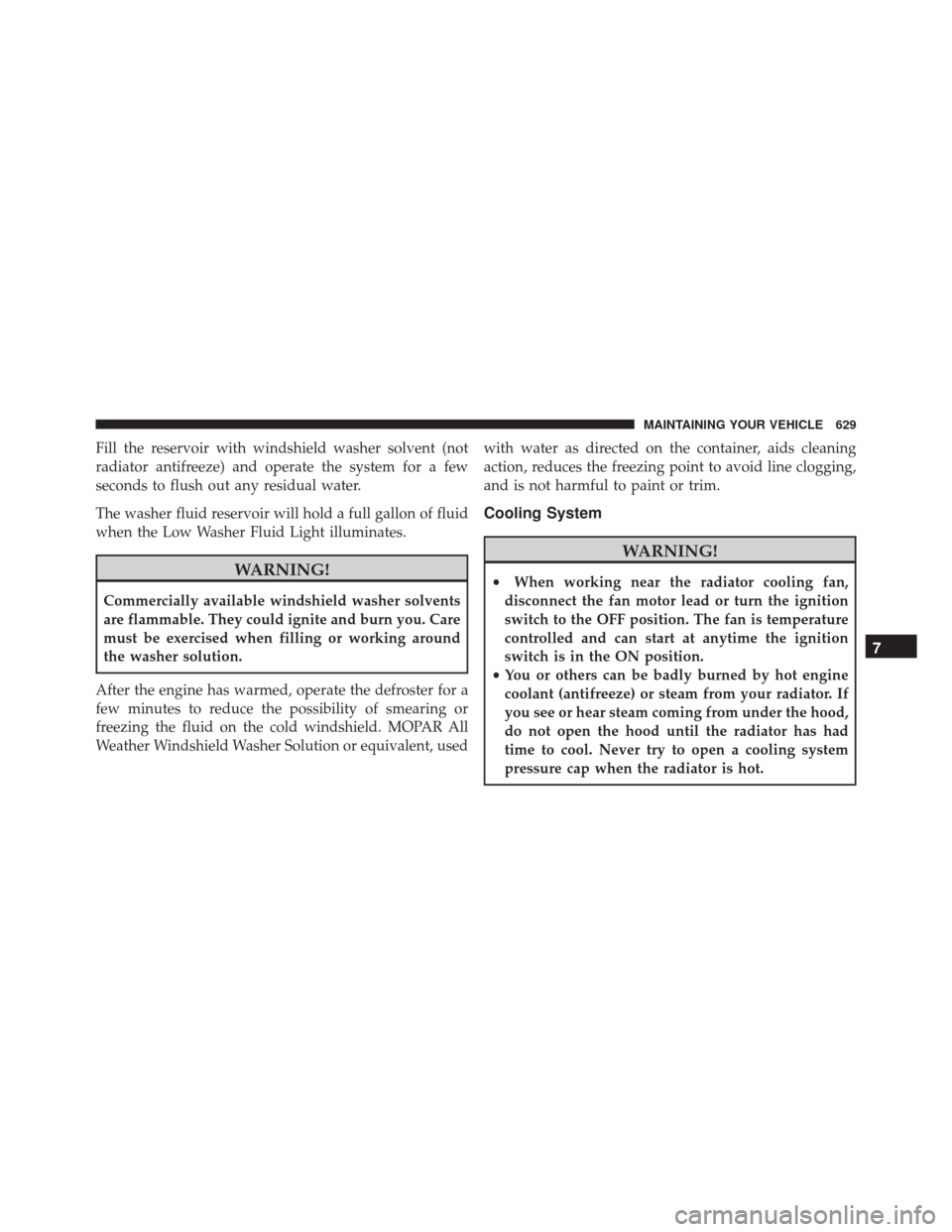
Fill the reservoir with windshield washer solvent (not
radiator antifreeze) and operate the system for a few
seconds to flush out any residual water.
The washer fluid reservoir will hold a full gallon of fluid
when the Low Washer Fluid Light illuminates.
WARNING!
Commercially available windshield washer solvents
are flammable. They could ignite and burn you. Care
must be exercised when filling or working around
the washer solution.
After the engine has warmed, operate the defroster for a
few minutes to reduce the possibility of smearing or
freezing the fluid on the cold windshield. MOPAR All
Weather Windshield Washer Solution or equivalent, used with water as directed on the container, aids cleaning
action, reduces the freezing point to avoid line clogging,
and is not harmful to paint or trim.
Cooling System
WARNING!
•
When working near the radiator cooling fan,
disconnect the fan motor lead or turn the ignition
switch to the OFF position. The fan is temperature
controlled and can start at anytime the ignition
switch is in the ON position.
• You or others can be badly burned by hot engine
coolant (antifreeze) or steam from your radiator. If
you see or hear steam coming from under the hood,
do not open the hood until the radiator has had
time to cool. Never try to open a cooling system
pressure cap when the radiator is hot.
7
MAINTAINING YOUR VEHICLE 629
Page 632 of 707
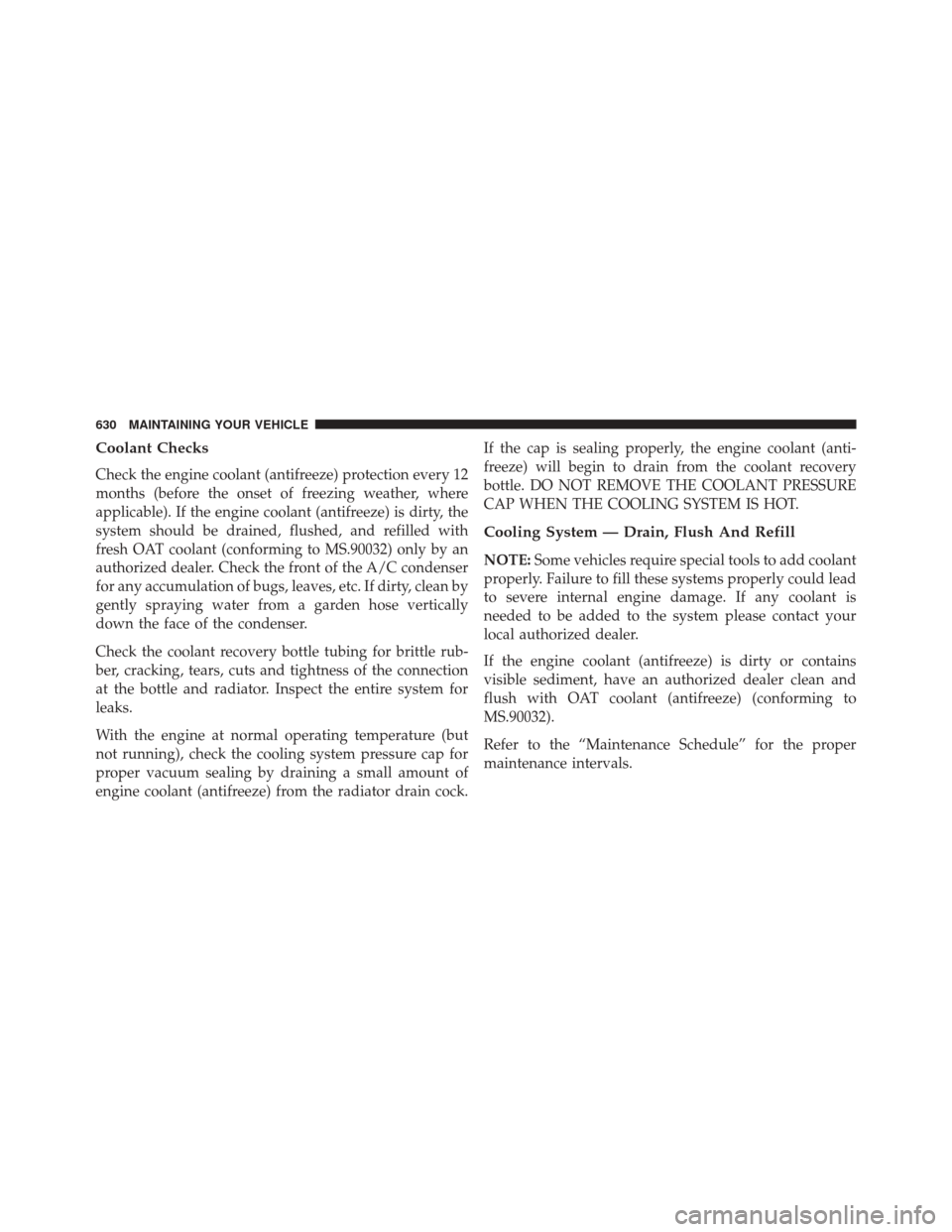
Coolant Checks
Check the engine coolant (antifreeze) protection every 12
months (before the onset of freezing weather, where
applicable). If the engine coolant (antifreeze) is dirty, the
system should be drained, flushed, and refilled with
fresh OAT coolant (conforming to MS.90032) only by an
authorized dealer. Check the front of the A/C condenser
for any accumulation of bugs, leaves, etc. If dirty, clean by
gently spraying water from a garden hose vertically
down the face of the condenser.
Check the coolant recovery bottle tubing for brittle rub-
ber, cracking, tears, cuts and tightness of the connection
at the bottle and radiator. Inspect the entire system for
leaks.
With the engine at normal operating temperature (but
not running), check the cooling system pressure cap for
proper vacuum sealing by draining a small amount of
engine coolant (antifreeze) from the radiator drain cock.If the cap is sealing properly, the engine coolant (anti-
freeze) will begin to drain from the coolant recovery
bottle. DO NOT REMOVE THE COOLANT PRESSURE
CAP WHEN THE COOLING SYSTEM IS HOT.
Cooling System — Drain, Flush And Refill
NOTE:
Some vehicles require special tools to add coolant
properly. Failure to fill these systems properly could lead
to severe internal engine damage. If any coolant is
needed to be added to the system please contact your
local authorized dealer.
If the engine coolant (antifreeze) is dirty or contains
visible sediment, have an authorized dealer clean and
flush with OAT coolant (antifreeze) (conforming to
MS.90032).
Refer to the “Maintenance Schedule” for the proper
maintenance intervals.
630 MAINTAINING YOUR VEHICLE
Page 635 of 707
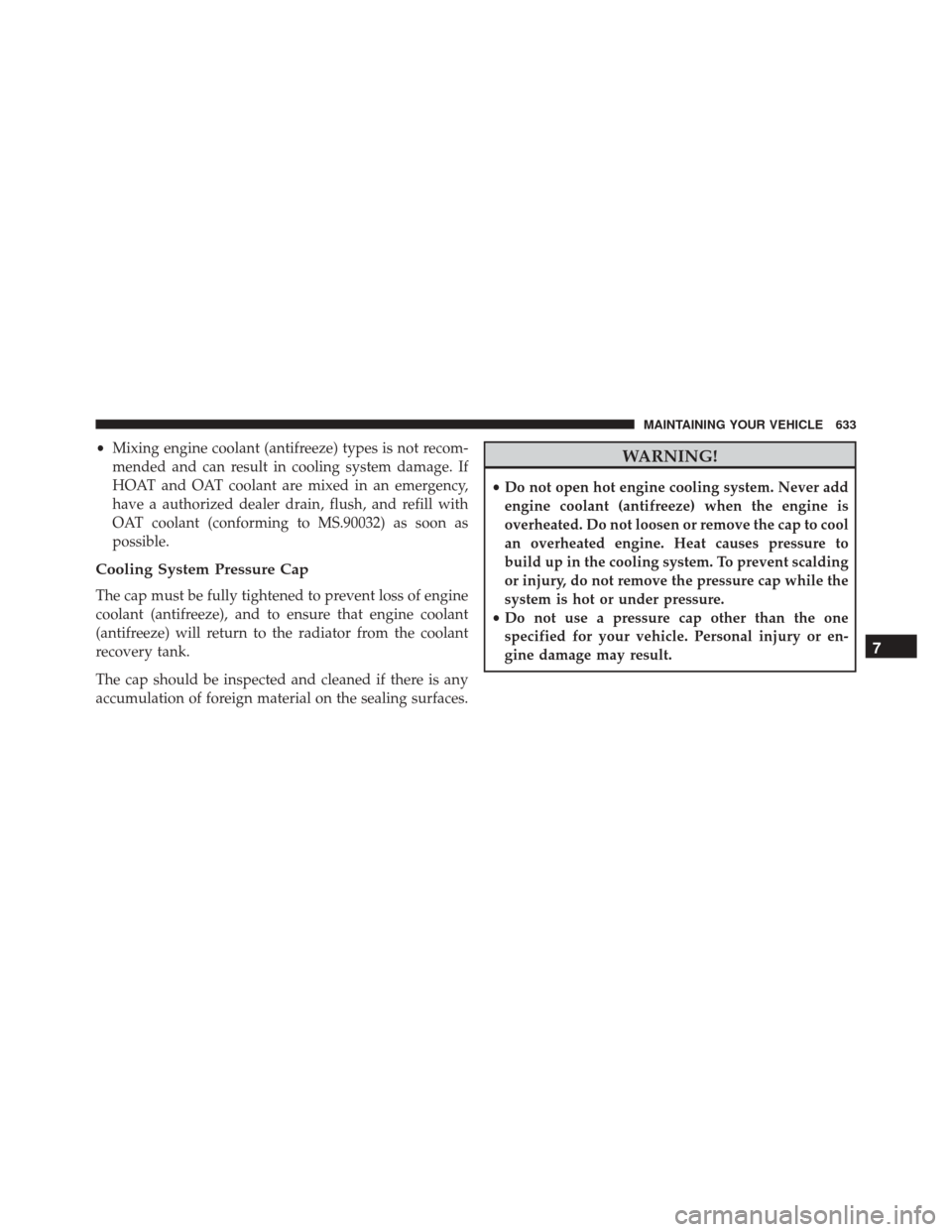
•Mixing engine coolant (antifreeze) types is not recom-
mended and can result in cooling system damage. If
HOAT and OAT coolant are mixed in an emergency,
have a authorized dealer drain, flush, and refill with
OAT coolant (conforming to MS.90032) as soon as
possible.
Cooling System Pressure Cap
The cap must be fully tightened to prevent loss of engine
coolant (antifreeze), and to ensure that engine coolant
(antifreeze) will return to the radiator from the coolant
recovery tank.
The cap should be inspected and cleaned if there is any
accumulation of foreign material on the sealing surfaces.
WARNING!
• Do not open hot engine cooling system. Never add
engine coolant (antifreeze) when the engine is
overheated. Do not loosen or remove the cap to cool
an overheated engine. Heat causes pressure to
build up in the cooling system. To prevent scalding
or injury, do not remove the pressure cap while the
system is hot or under pressure.
• Do not use a pressure cap other than the one
specified for your vehicle. Personal injury or en-
gine damage may result.
7
MAINTAINING YOUR VEHICLE 633
Page 636 of 707
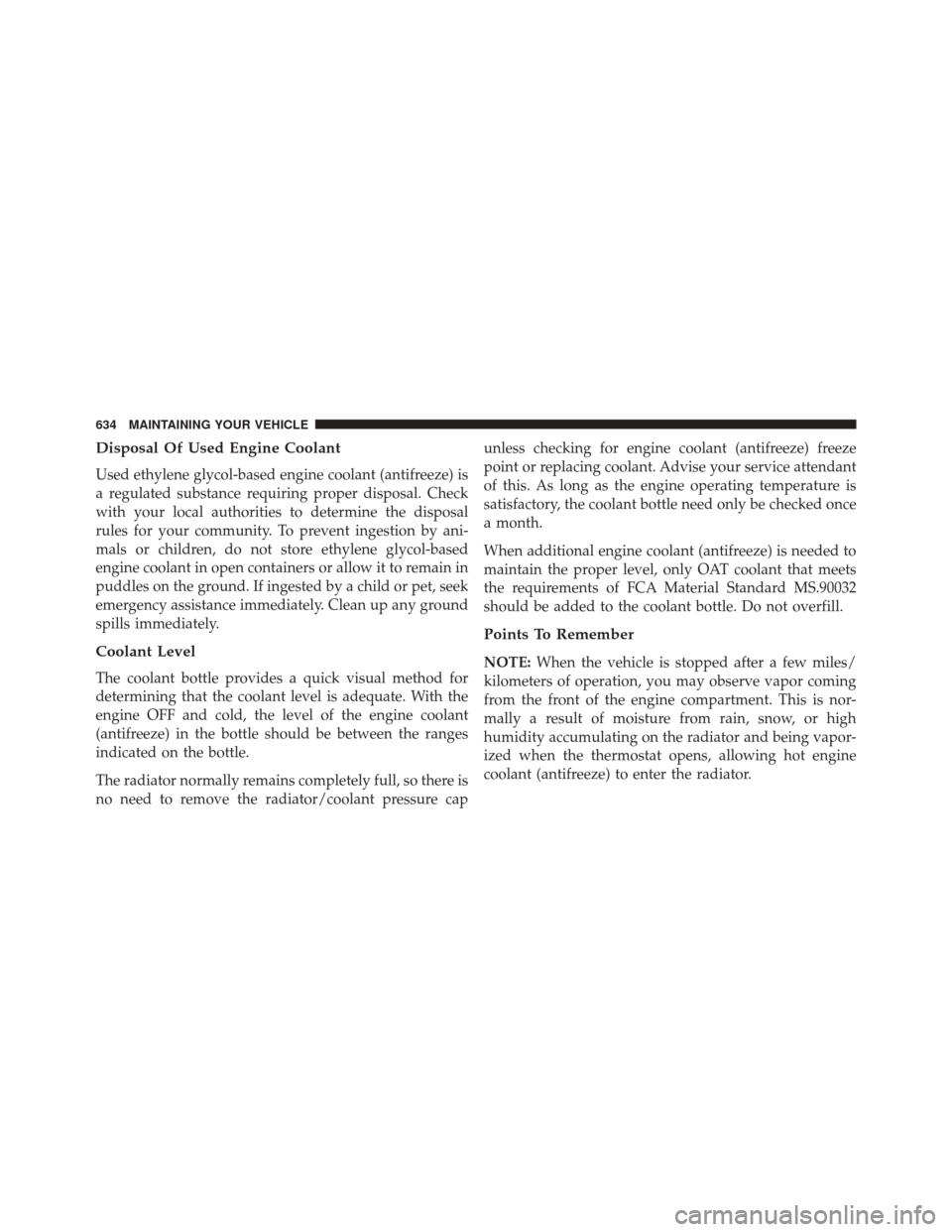
Disposal Of Used Engine Coolant
Used ethylene glycol-based engine coolant (antifreeze) is
a regulated substance requiring proper disposal. Check
with your local authorities to determine the disposal
rules for your community. To prevent ingestion by ani-
mals or children, do not store ethylene glycol-based
engine coolant in open containers or allow it to remain in
puddles on the ground. If ingested by a child or pet, seek
emergency assistance immediately. Clean up any ground
spills immediately.
Coolant Level
The coolant bottle provides a quick visual method for
determining that the coolant level is adequate. With the
engine OFF and cold, the level of the engine coolant
(antifreeze) in the bottle should be between the ranges
indicated on the bottle.
The radiator normally remains completely full, so there is
no need to remove the radiator/coolant pressure capunless checking for engine coolant (antifreeze) freeze
point or replacing coolant. Advise your service attendant
of this. As long as the engine operating temperature is
satisfactory, the coolant bottle need only be checked once
a month.
When additional engine coolant (antifreeze) is needed to
maintain the proper level, only OAT coolant that meets
the requirements of FCA Material Standard MS.90032
should be added to the coolant bottle. Do not overfill.
Points To Remember
NOTE:
When the vehicle is stopped after a few miles/
kilometers of operation, you may observe vapor coming
from the front of the engine compartment. This is nor-
mally a result of moisture from rain, snow, or high
humidity accumulating on the radiator and being vapor-
ized when the thermostat opens, allowing hot engine
coolant (antifreeze) to enter the radiator.
634 MAINTAINING YOUR VEHICLE
Page 688 of 707
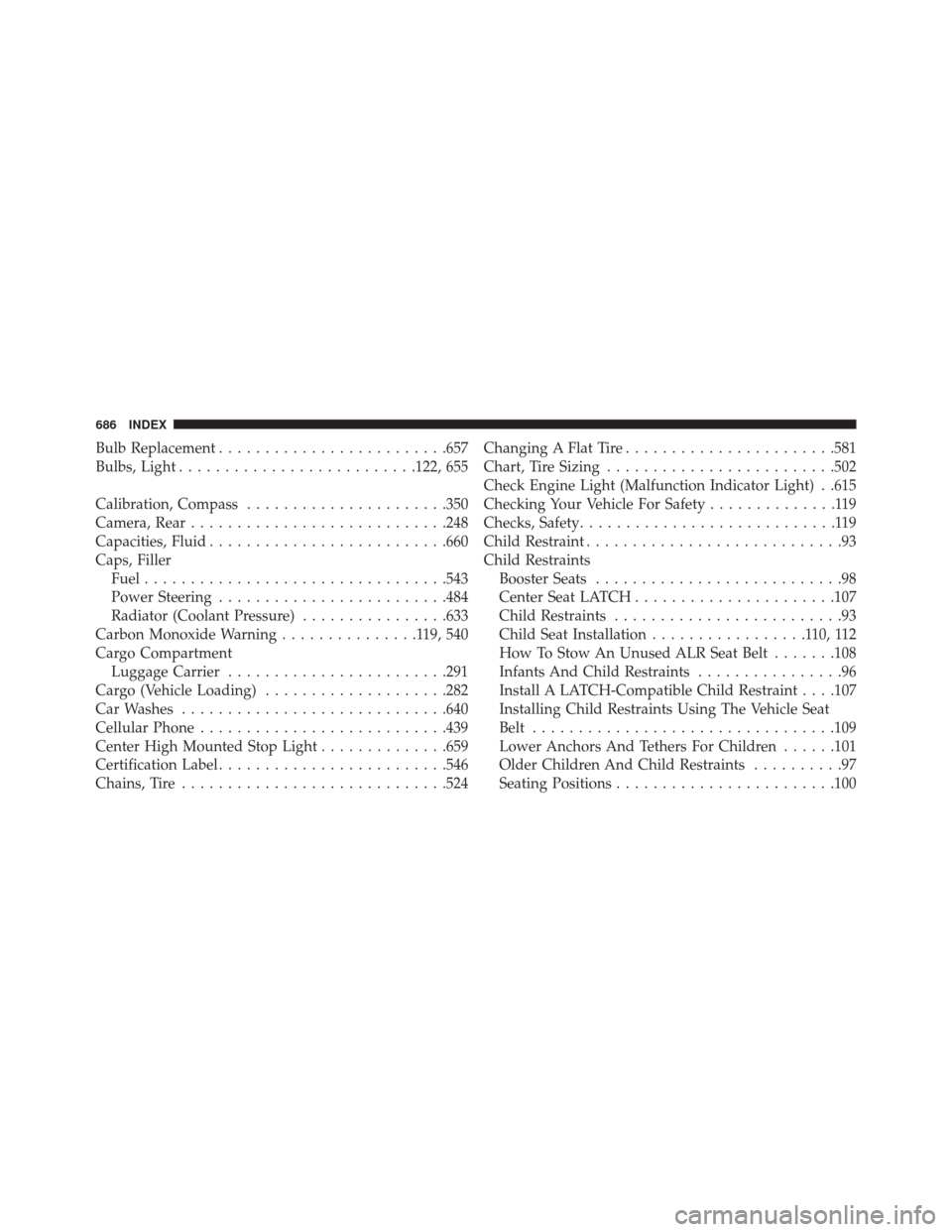
Bulb Replacement........................ .657
Bulbs, Light ......................... .122, 655
Calibration, Compass ..................... .350
Camera, Rear ........................... .248
Capacities, Fluid ......................... .660
Caps, Filler Fuel ................................ .543
Power Steering ........................ .484
Radiator (Coolant Pressure) ................633
Carbon Monoxide Warning ...............119,540
Cargo Compartment Luggage Carrier ....................... .291
Cargo (Vehicle Loading) ....................282
Car Washes ............................ .640
Cellular Phone .......................... .439
Center High Mounted Stop Light ..............659
Certification Label ........................ .546
Chains, Tire ............................ .524Changing A Flat Tire
...................... .581
Chart, Tire Sizing ........................ .502
Check Engine Light (Malfunction Indicator Light) . .615
Checking Your Vehicle For Safety ..............119
Checks, Safety ............................119
Child Restraint ............................93
Child Restraints Booster Seats ...........................98
Center Seat LATCH ..................... .107
Child Restraints .........................93
Child Seat Installation .................110,112
How To Stow An Unused ALR Seat Belt .......108
Infants And Child Restraints ................96
Install A LATCH-Compatible Child Restraint . . . .107
Installing Child Restraints Using The Vehicle Seat
Belt ................................ .109
Lower Anchors And Tethers For Children ......101
Older Children And Child Restraints ..........97
Seating Positions ....................... .100
686 INDEX
Page 689 of 707
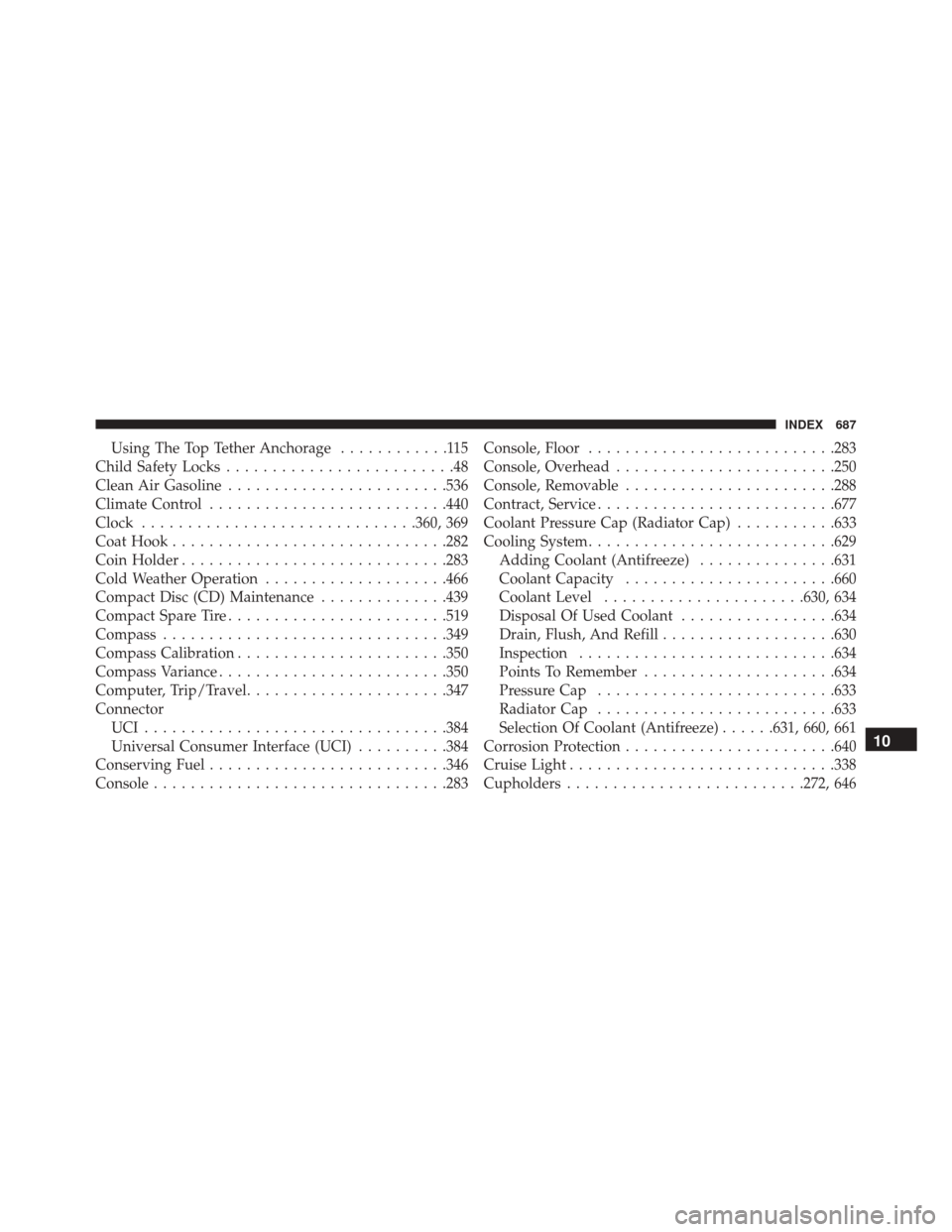
Using The Top Tether Anchorage............115
Child Safety Locks .........................48
Clean Air Gasoline ....................... .536
Climate Control ......................... .440
Clock ............................. .360, 369
Coat Hook ............................. .282
Coin Holder ............................ .283
Cold Weather Operation ....................466
Compact Disc (CD) Maintenance ..............439
Compact Spare Tire ....................... .519
Compass .............................. .349
Compass Calibration ...................... .350
Compass Variance ........................ .350
Computer, Trip/Travel ..................... .347
Connector UCI................................ .384
Universal Consumer Interface (UCI) ..........384
Conserving Fuel ......................... .346
Console ............................... .283Console, Floor
.......................... .283
Console, Overhead ....................... .250
Console, Removable ...................... .288
Contract, Service ......................... .677
Coolant Pressure Cap (Radiator Cap) ...........633
Cooling System .......................... .629
Adding Coolant (Antifreeze) ...............631
Coolant Capacity ...................... .660
Coolant Level ..................... .630, 634
Disposal Of Used Coolant .................634
Drain, Flush, And Refill ...................630
Inspection ........................... .634
Points To Remember .....................634
Pressure Cap ......................... .633
Radiator Cap ......................... .633
Selection Of Coolant (Antifreeze) ......631, 660, 661
Corrosion Protection ...................... .640
Cr
uise Light ............................ .338
Cupholders ......................... .272, 64610
INDEX 687
Page 698 of 707

Opener, Garage Door (HomeLink).............254
Operator Manual (Owner’s Manual) .............4
Outside Rearview Mirrors ................131, 133
Overhead Console ........................ .250
Overhead Travel Information Center ............250
Overheating, Engine ...................... .567
Owner’s Manual (Operator Manual) ..........4,679
Paint Care ............................. .640
Panic Alarm ..............................25
Parking Brake ........................... .485
ParkSense System, Rear .....................240
Personal Settings ......................... .352
Pets ...................................117
Placard, Tire And Loading Information ..........508
Power Brakes .............................. .488
Door Locks ............................36
Lift Gate ..............................52 Mirrors
............................. .134
Outlet (Auxiliary Electrical Outlet) ...........267
Seats ............................... .184
Sliding Door ...........................44
Steering .......................... .483, 484
Sunroof ............................. .264
Windows ..............................38
Power Steering Fluid ...................... .663
Pregnant Women And Seat Belts ...............70
Preparation For Jacking .....................589
Pretensioners Seat Belts ..............................71
Programmable Electronic Features .............352
Radial Ply Tires ......................... .515
Radiator Cap (Coolant Pressure Cap) ...........633
Radio Operation ......................... .439
Radio Remote Controls .....................437
Rear Air Conditioning ...................445, 455
696 INDEX